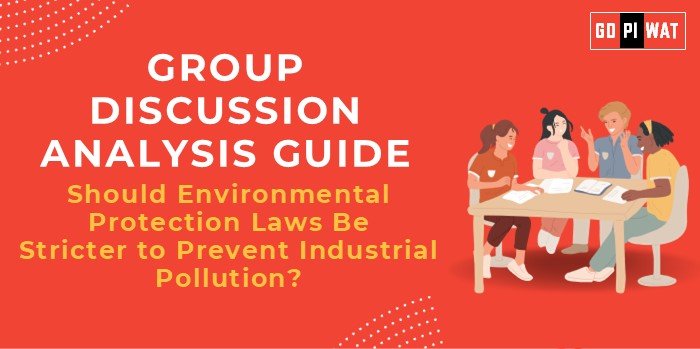📋 Group Discussion Analysis Guide: Should Environmental Protection Laws Be Stricter to Prevent Industrial Pollution?
🌐 Introduction to the Topic
- Opening Context: Industrial pollution significantly contributes to environmental degradation, with global carbon emissions surpassing 36.8 billion metric tons in 2022, threatening ecosystems and human health alike.
- Topic Background: The need for stricter environmental laws gained momentum after landmark environmental disasters like the Bhopal Gas Tragedy (1984). Globally, policies like the Paris Agreement emphasize collective action, but enforcement gaps persist.
📊 Quick Facts and Key Statistics
- Industrial Emissions: Account for 24% of global greenhouse gas emissions (UNEP, 2023).
- Water Pollution: 70% of industrial waste in developing countries is untreated (World Bank).
- India’s Pollution Index: Ranked 5th globally for highest pollution levels (IQAir, 2023).
- Legislation Penetration: Over 120 nations have air quality laws, yet compliance is less than 40% (UNEP).
- Economic Impact: Pollution-related health costs in India account for 8.5% of GDP (WHO).
👥 Stakeholders and Their Roles
- Government Agencies: Enforce regulations, implement policies, monitor compliance (e.g., Central Pollution Control Board in India).
- Industries: Adopt eco-friendly practices, comply with environmental standards.
- Citizens: Advocate for greener practices, hold stakeholders accountable.
- International Organizations: Provide frameworks and funding for sustainable practices (e.g., UNEP, WHO).
- NGOs: Raise awareness, litigate against violations.
🏆 Achievements and Challenges
Achievements:
- India’s National Clean Air Programme aims to reduce PM2.5 by 30% by 2024.
- EU Emission Trading System: Over 35% reduction in industrial emissions since 2005.
- Sweden: Leader in industrial waste management with 99% waste recycling.
Challenges:
- Enforcement Gaps: Only 30% of Indian industries comply with effluent norms.
- Technological Barriers: Limited access to clean technology in developing nations.
- Political Resistance: Economic concerns hinder stricter laws.
Global Comparisons:
- China’s pollution control policies reduced Beijing’s air pollution by 35% between 2013 and 2017.
- The US Clean Air Act significantly improved air quality but faces political rollback threats.
📝 Structured Arguments for Discussion
- Supporting Stance: “Stricter laws will enforce accountability and catalyze industrial innovation toward greener technologies.”
- Opposing Stance: “Rigid laws could stifle economic growth, particularly for small and medium enterprises.”
- Balanced Perspective: “Stricter laws are necessary but should include phased implementation and incentives for compliance.”
🚀 Effective Discussion Approaches
- Opening Approaches:
- Cite global examples like the EU’s emissions success.
- Highlight local environmental disasters and their socioeconomic impacts.
- Counter-Argument Handling:
- Present evidence of economic benefits from green industries (e.g., renewable energy sector growth).
- Emphasize long-term health and ecological savings.
📈 Strategic Analysis of Strengths and Weaknesses
- Strengths: Increased accountability, improved public health, alignment with global goals.
- Weaknesses: Enforcement challenges, potential for industrial pushback.
- Opportunities: Technological advancement, global collaborations.
- Threats: Resistance from influential industries, economic disruption risks.
🎓 Connecting with B-School Applications
- Real-World Applications: Environmental protection themes can link to sustainability projects in finance or operations.
- Sample Interview Questions:
- “What role do stricter environmental laws play in sustainable business practices?”
- “How can industries balance compliance and profitability?”
- Insights for Students:
- Explore sustainable investment opportunities, eco-friendly operations, and leadership roles in green initiatives.


